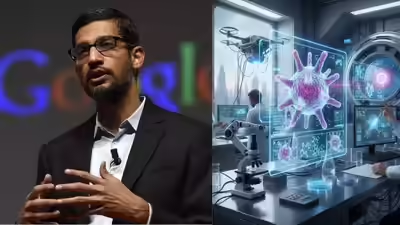In a groundbreaking development for biomedical research, Google’s advanced AI, C2S-Scale 27B, developed in collaboration with Yale University and based on the Gemma framework, has successfully used to generate a novel hypothesis about cancer cell behaviour — a hypothesis later experimentally validated in living human cells.
Google CEO Sundar Pichai hailed this achievement as a major milestone in the integration of artificial intelligence with laboratory science, emphasizing that the discovery could guide future preclinical and clinical research and potentially reveal new pathways for cancer therapy.
🤖 How Google AI Is Decoding Cancer Through Cellular Language
At the heart of this breakthrough is the C2S-Scale 27B model’s extraordinary ability to “understand” biology. Trained on over one billion single-cell profiles, the transforms raw molecular data into what researchers call “cell sentences”. This enables the AI to interpret cellular communication and context, effectively learning the “language” of cells.
💡 Key Insight: As biotech entrepreneur Bryan Johnson explained, the model “listened” to the signals of cells and generated a hypothesis that real biological experiments later confirmed.
This represents a turning point for biomedical research, allowing it to reason about complex systems and propose new scientific ideas rather than simply summarizing existing knowledge.
💊 Discovery of a Potential Cancer Therapy Pathway
The AI suggested that the drug silmitasertib could increase antigen presentation in cancer cells by nearly 50% under low interferon conditions.
🧫 Why it matters: Antigen presentation is the process by which tumour cells display fragments of abnormal proteins on their surface, alerting the immune system to attack them. Enhancing this process could make previously “invisible” tumours detectable to immune cells, strengthening the body’s natural defenses against cancer.
✅ Experiments in human cell models confirmed the prediction. This finding is particularly promising for “cold tumours”, which are notorious for evading immune detection and resisting conventional therapies.
If validated in further preclinical and clinical studies, these results could pave the way for new immunotherapy approaches, offering hope for patients with cancers that are especially difficult to treat.
🌟 Transforming Scientific Discovery
This milestone highlights a new era for in medical research. Rather than merely analyzing existing datasets, systems like C2S-Scale 27B can now generate entirely new scientific hypotheses, bridging computational predictions and experimental validation.
⚠️ While extensive preclinical and clinical testing remains essential before these driven insights can translate into patient treatments, this achievement demonstrates potential as a true partner in science, capable of accelerating discovery, sparking innovation, and guiding research in unprecedented ways.
🌍 Open Access for Global Collaboration
In a move to democratize cutting-edge biomedical research, Google has made the C2S-Scale model publicly available on platforms like Hugging Face and GitHub.
🔗 This transparency allows scientists worldwide to explore the model’s capabilities, test its predictions, and build upon its foundation — fostering global collaboration in the fight against cancer.
📝 Final Thoughts
Google’s C2S-Scale 27B model marks a historic milestone in driven biomedical research. By moving beyond data analysis to hypothesis generation, is becoming an active partner in scientific discovery.
⚡ While human expertise and rigorous testing remain crucial, this achievement showcases the potential for to accelerate breakthroughs in cancer research, inspire innovative therapies, and redefine how science is conducted in the 21st century.
The collaboration between and laboratory science is no longer a futuristic vision — it’s happening today, and its impact could transform medicine for generations to come.







Leave A Comment